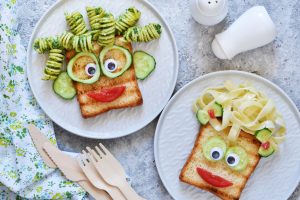Dinnertime for the Family with ADHD: How to make family meals more enjoyable for all
 Dinnertime can be a wonderful opportunity to catch up with your family, learn what’s going on in each other’s lives and share the delightful experience of a tasty meal. It has the potential to be an enjoyable break in your day where you can check-in with your family (and yourself) and connect with each other. However, if that doesn’t sound like your experience, you’re not alone. Dinnertime for families living with ADHD can look quite different. Your child or teen face unique challenges that make it difficult for them to calmly transition to the table and be ready to eat what’s served. I’ll discuss some of these challenges as well as how to help everyone feel more prepared and excited to enjoy a meal with one another.
Dinnertime can be a wonderful opportunity to catch up with your family, learn what’s going on in each other’s lives and share the delightful experience of a tasty meal. It has the potential to be an enjoyable break in your day where you can check-in with your family (and yourself) and connect with each other. However, if that doesn’t sound like your experience, you’re not alone. Dinnertime for families living with ADHD can look quite different. Your child or teen face unique challenges that make it difficult for them to calmly transition to the table and be ready to eat what’s served. I’ll discuss some of these challenges as well as how to help everyone feel more prepared and excited to enjoy a meal with one another.
Why mealtimes can be challenging for kids and teens with ADHD
Getting everyone to the dinner table
Kids and adult with ADHD often get overwhelmed when they’re asked to stop one activity and start another. Shifting from one task to another involves executive functioning skills such as impulse control, cognitive flexibility and organization that they might struggle with. Knowing how to wrap up where they are in a project, remembering where they’re leaving off when it’s time to return, and moving onto something new can be challenging. Hyperfocus on a project or activity makes this even tougher because of a lack of awareness of how time passes. Think about how time goes fast when you’re having fun but even more so. Leaving a fun computer game or playing hoops with your neighbor to eat a meal with your parents, no matter how many warnings your mom or dad gave you, can still come as a shock that they now have to process. So getting to the table with a smile may well not happen.
Arriving in a good mood
 Ideally, family members come together around the table in a friendly, happy mood. However, that can be a lot to expect at dinnertime for your ADHD family. Expecting kids to reign in emotions from the events of their day or even their last activity might be too much to ask. If they’re overwhelmed with having to stop what they were doing to eat at what they think is an inconvenient time, they’ll probably bring this upset to the table. They might also have had a difficult day and aren’t up for cheerfully sitting around you to eat dinner. Displeasure about the food or anxiety about the noise or conversation could also contribute to a foul mood. Chat with your child or teen about how to join the family and participate in the meal with more equanimity. Learning how to do this takes time and practice. Eating what’s served We all can agree that eating well is one of the keys to living well. Yet, nutrition can be a hard enough thing to handle for yourself, let alone when you are raising a picky eater. Having a well-rounded diet is important, yet it can seem almost impossible with a sensory sensitive child or teen with ADHD who, for example, only likes white-colored foods. As you try to get a handle on it and ensure that your family is getting all of the vitamins and minerals they need, things can get a little dicey (pun definitely intended) with so many different food preferences. Dinnertime for your ADHD family can feel like a rollercoaster ride. “Picky eaters” make up 26% of the American population, while anywhere from 13 to 22% of children are reported as “picky eaters” at any given time. People rarely consider it a chronic problem since it is so prevalent in children, especially aged 2-5, and see it more as a passing phase. However, about 40% of children are reported to have inconveniently specific eating preferences that last more than two years, and this is especially common for children diagnosed with ADHD.
Ideally, family members come together around the table in a friendly, happy mood. However, that can be a lot to expect at dinnertime for your ADHD family. Expecting kids to reign in emotions from the events of their day or even their last activity might be too much to ask. If they’re overwhelmed with having to stop what they were doing to eat at what they think is an inconvenient time, they’ll probably bring this upset to the table. They might also have had a difficult day and aren’t up for cheerfully sitting around you to eat dinner. Displeasure about the food or anxiety about the noise or conversation could also contribute to a foul mood. Chat with your child or teen about how to join the family and participate in the meal with more equanimity. Learning how to do this takes time and practice. Eating what’s served We all can agree that eating well is one of the keys to living well. Yet, nutrition can be a hard enough thing to handle for yourself, let alone when you are raising a picky eater. Having a well-rounded diet is important, yet it can seem almost impossible with a sensory sensitive child or teen with ADHD who, for example, only likes white-colored foods. As you try to get a handle on it and ensure that your family is getting all of the vitamins and minerals they need, things can get a little dicey (pun definitely intended) with so many different food preferences. Dinnertime for your ADHD family can feel like a rollercoaster ride. “Picky eaters” make up 26% of the American population, while anywhere from 13 to 22% of children are reported as “picky eaters” at any given time. People rarely consider it a chronic problem since it is so prevalent in children, especially aged 2-5, and see it more as a passing phase. However, about 40% of children are reported to have inconveniently specific eating preferences that last more than two years, and this is especially common for children diagnosed with ADHD.
7 tips to help make dinnertime more enjoyable for your ADHD family
1. Ask your child or teen about their food preferences.
Do you consider your kid or teen a picky eater? Not being interested in the meal served can add stress at dinnertime for any family. My guess is they aren’t selective about their foods because they prefer dine exclusively on lobster rolls or prime rib. Rather, kids with ADHD who have strong taste preferences often like familiar foods, like crackers, mac and cheese or PB&Js.  Eating their preferred foods consistently might not offer them the best nutrition. But the stress of needing to swallow foods you don’t like–while also in an upset mood or heated emotional environment–isn’t good for the body, either. Having a familiar, fulfilling meal can help them get the sustenance and energy they need without needing to add more stress to an already stressful day. Ask them questions about the foods they like. Is it the flavor, the texture, the fact they can hold it in their hands? This will help you better grasp their eating needs as well as gain understanding about their experiences. Kids with ADHD want to be understood more than judged. Taking the time to inquire about their perceptive is meaningful to them and helpful to you.
Eating their preferred foods consistently might not offer them the best nutrition. But the stress of needing to swallow foods you don’t like–while also in an upset mood or heated emotional environment–isn’t good for the body, either. Having a familiar, fulfilling meal can help them get the sustenance and energy they need without needing to add more stress to an already stressful day. Ask them questions about the foods they like. Is it the flavor, the texture, the fact they can hold it in their hands? This will help you better grasp their eating needs as well as gain understanding about their experiences. Kids with ADHD want to be understood more than judged. Taking the time to inquire about their perceptive is meaningful to them and helpful to you.
2. Take their preferences into consideration when introducing new foods at mealtime.
 If you’re concerned about your kid’s limited food preferences, try working with them slowly over time on expanding their food preferences. Forcing them to eat a meal that you might love, but they don’t, will only lead to an unpleasant experience for your family. See if you can find a new food once in a while that might be a healthier version of their favorite foods, but still meet their preferences. If your child loves french fries, try an often healthier alternative – sweet potato fries. Then, gradually move on to other similar foods. When they’re trying new foods, don’t set your expectations too high. You might think you have all the information and that you definitely got it right this time. The bottom line is–it’s still up to them to decide, and it still might not work. Prepare yourself for this scenario so you don’t give a strong reaction in the moment. The goal isn’t to shame your child or teen into eating. Showing support and acknowledge for their courage in taking a risk will help them feel more comfortable with trying new foods in the future.
If you’re concerned about your kid’s limited food preferences, try working with them slowly over time on expanding their food preferences. Forcing them to eat a meal that you might love, but they don’t, will only lead to an unpleasant experience for your family. See if you can find a new food once in a while that might be a healthier version of their favorite foods, but still meet their preferences. If your child loves french fries, try an often healthier alternative – sweet potato fries. Then, gradually move on to other similar foods. When they’re trying new foods, don’t set your expectations too high. You might think you have all the information and that you definitely got it right this time. The bottom line is–it’s still up to them to decide, and it still might not work. Prepare yourself for this scenario so you don’t give a strong reaction in the moment. The goal isn’t to shame your child or teen into eating. Showing support and acknowledge for their courage in taking a risk will help them feel more comfortable with trying new foods in the future.
3. Set up reminders leading up to mealtime.
Give your child or teen time to prepare for an upcoming meal time. Use a reminder system to let your child or teen know that food will be prepared and ready to serve soon. I’m not referring to yelling up the stairs, “Dinner in 10!” Raising your voice won’t support any calm transition. It can actually be triggering, so it’s best to avoid at all times, even when it’s not out of anger or frustration. If your child or teen has headphones on or their door closed, they’re not going to hear you anyway.  Instead, knock on their door or calmly approach them (while respecting their privacy and physical boundaries) and let them know that dinner will be ready in 15 or 10 minutes and then with a 5 minute warning. Ask them to acknowledge the reminder using the Rule of Three so you both understand that they get it. Another option is helping them set up reminders in their phone, watch, alarm clock or other device. This promotes their independence and helps them build strategies for time management skills.
Instead, knock on their door or calmly approach them (while respecting their privacy and physical boundaries) and let them know that dinner will be ready in 15 or 10 minutes and then with a 5 minute warning. Ask them to acknowledge the reminder using the Rule of Three so you both understand that they get it. Another option is helping them set up reminders in their phone, watch, alarm clock or other device. This promotes their independence and helps them build strategies for time management skills.
4. Keep your child or teen informed with what’s on the menu.
Inform your child or teen about what’s for dinner. This eliminates unknown variables that might make them anxious about mealtime. Kids and teens with ADHD struggle with enough anxiety in their lives; knowing what’s next on the menu takes away unnecessary anticipation and worry. They might also plan accordingly – perhaps avoiding a similar meal at lunchtime.
5. Better yet, let them have a say in what’s on the menu.
If your child or teen helps create the menu, then they’re more likely to want to eat what’s on it. Chances are, not everyone in the family agrees on the same food preferences. You will likely have to compromise and agree to mix things up. If there is a food you all love and crave every week, like pizza, then consider having a weekly Friday Pizza night! Transforming dinnertime into an ADHD family tradition is fun and promotes family bonds.  Weekly family meetings are a perfect time to discuss ideas for upcoming meals. Collaborating on meals takes pressure off of planning and shopping for meals on your own. It also leads to a happier outcome for all and teaches essential living skills. If you’re looking for new ideas or inspiration, try looking on Pinterest from saved or new recipes, or dusting off those cook books to pass around. Encourage your kids to notice what they crave throughout the week, too. They can write them down or text them to you. Then, talk about this during your weekly family meeting.
Weekly family meetings are a perfect time to discuss ideas for upcoming meals. Collaborating on meals takes pressure off of planning and shopping for meals on your own. It also leads to a happier outcome for all and teaches essential living skills. If you’re looking for new ideas or inspiration, try looking on Pinterest from saved or new recipes, or dusting off those cook books to pass around. Encourage your kids to notice what they crave throughout the week, too. They can write them down or text them to you. Then, talk about this during your weekly family meeting.
6. Have easy, preferred food options available as back-up.
It helps to know if there’s food on the menu that your kid knows they won’t like. That way, you won’t make more than necessary, and there will be no upsetting surprises. You can prepare (or they can do this themselves) a safe choice ready for them to eat instead. Maybe that’s a quick sandwich or an easy, go-to microwave meal.
7. Involve your child or teen in the meal prep process.
 If there’s time and interest, involve your child or teen with the process of prepping, cooking and serving the meals. This is a great way to get them in the ready-to-eat mindset and teach them how to cook. Their body and mind are excited to eat thanks to the food’s aroma and occasional taste. They’re also looking forward to relaxing at the table after some physical work. They’re ready to jump in as soon as it’s ready! Making and serving food is also a time to get creative– a common strength for people with ADHD! Whether it’s trying a different ingredient, cooking it differently, serving it on the dish in a fun design or setting up the table with a new aesthetic, it can help your kid get engaged and lead to a fun, enjoyable meal with your family.
If there’s time and interest, involve your child or teen with the process of prepping, cooking and serving the meals. This is a great way to get them in the ready-to-eat mindset and teach them how to cook. Their body and mind are excited to eat thanks to the food’s aroma and occasional taste. They’re also looking forward to relaxing at the table after some physical work. They’re ready to jump in as soon as it’s ready! Making and serving food is also a time to get creative– a common strength for people with ADHD! Whether it’s trying a different ingredient, cooking it differently, serving it on the dish in a fun design or setting up the table with a new aesthetic, it can help your kid get engaged and lead to a fun, enjoyable meal with your family.
Read more blog posts:
- ADHD and Negativity: Why ADHD kids and teens say “No” and how to help them communicate
- Create successful neurodiverse family outings today: Time to connect with the great outdoors!
- Post-Pandemic Self-Care for Parents: 12 Tips for Wellness Practices in a New Normal
https://drsharonsaline.com/product/managing-technology-families-video/ https://drsharonsaline.com/product/home-seminar/
